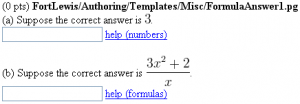Difference between revisions of "FormulaAnswer1"
Jump to navigation
Jump to search
Paultpearson (talk | contribs) |
|||
| Line 154: | Line 154: | ||
[[Category:Top]] |
[[Category:Top]] |
||
[[Category:Authors]] |
[[Category:Authors]] |
||
| + | [[Category:Sample Problems]] |
||
Revision as of 15:39, 3 January 2012
Answer is a Number or a Formula
This PG code shows how to write a question whose answer is a number or a formula.
- Download file: File:FormulaAnswer1.txt (change the file extension from txt to pg when you save it)
- File location in NPL:
FortLewis/Authoring/Templates/Misc/FormulaAnswer1.pg
| PG problem file | Explanation |
|---|---|
|
Problem tagging: |
|
DOCUMENT(); loadMacros( "PGstandard.pl", "MathObjects.pl", "AnswerFormatHelp.pl", ); TEXT(beginproblem()); |
Initialization: |
Context("Numeric");
$a = non_zero_random(-9,9,1);
do { $b = random(2,9,1); } until ( $b != $a );
$answer1 = Compute("$a");
$answer2 = Compute("$a x^($b) + $b")->reduce();
|
Setup:
We use |
Context()->texStrings;
BEGIN_TEXT
Enter \( $answer1 \):
\{ ans_rule(20) \}
\{ AnswerFormatHelp("numbers") \}
$BR
$BR
Enter \( $answer2 \):
\{ ans_rule(20) \}
\{ AnswerFormatHelp("formulas") \}
END_TEXT
Context()->normalStrings;
|
Main Text: |
$showPartialCorrectAnswers = 1; ANS( $answer1->cmp() ); ANS( $answer2->cmp() ); |
Answer Evaluation: |
Context()->texStrings;
BEGIN_SOLUTION
${PAR}SOLUTION:${PAR}
Solution explanation goes here.
END_SOLUTION
Context()->normalStrings;
COMMENT('MathObject version.');
ENDDOCUMENT();
|
Solution: |
